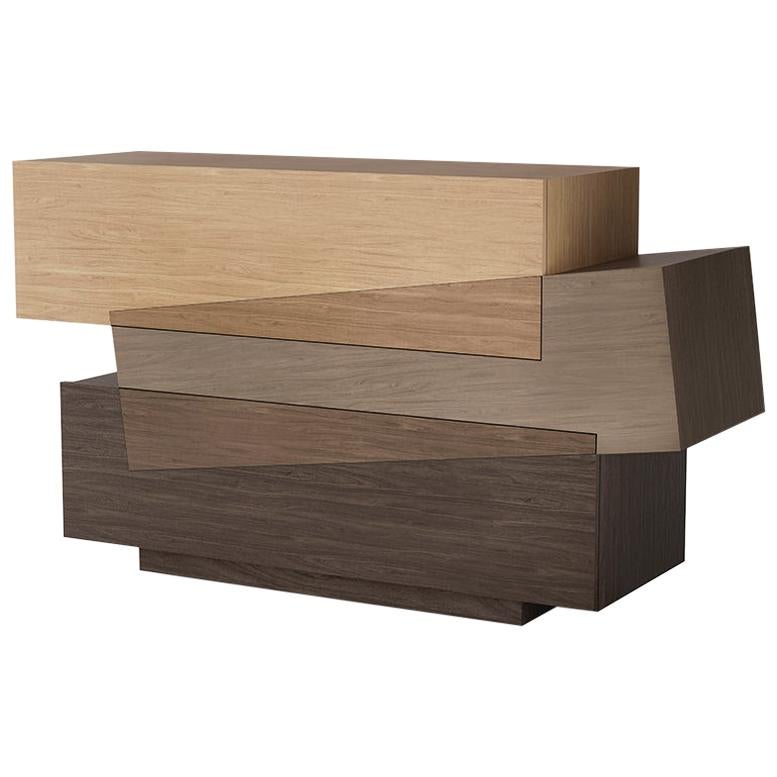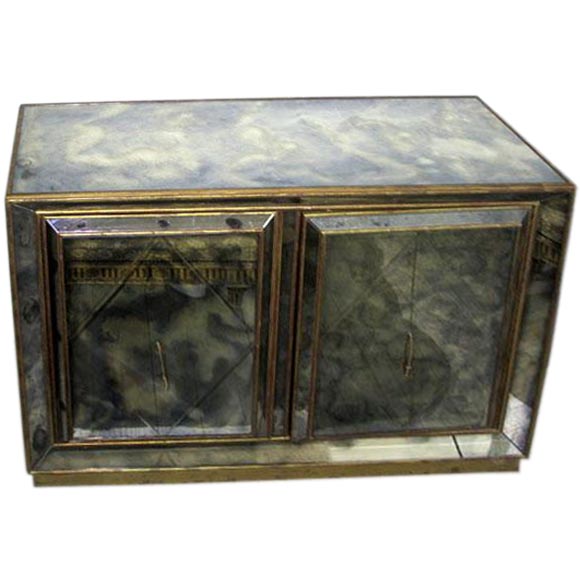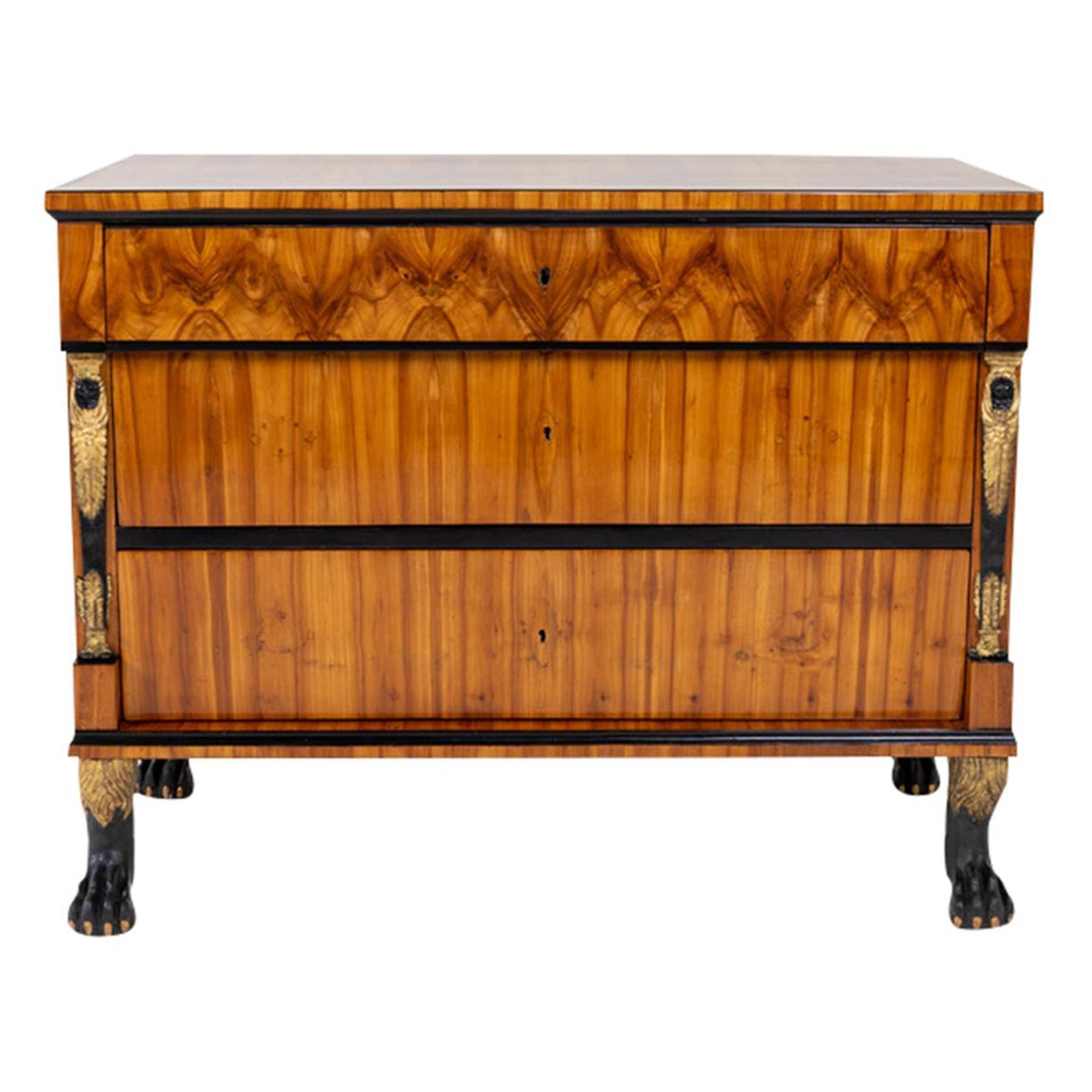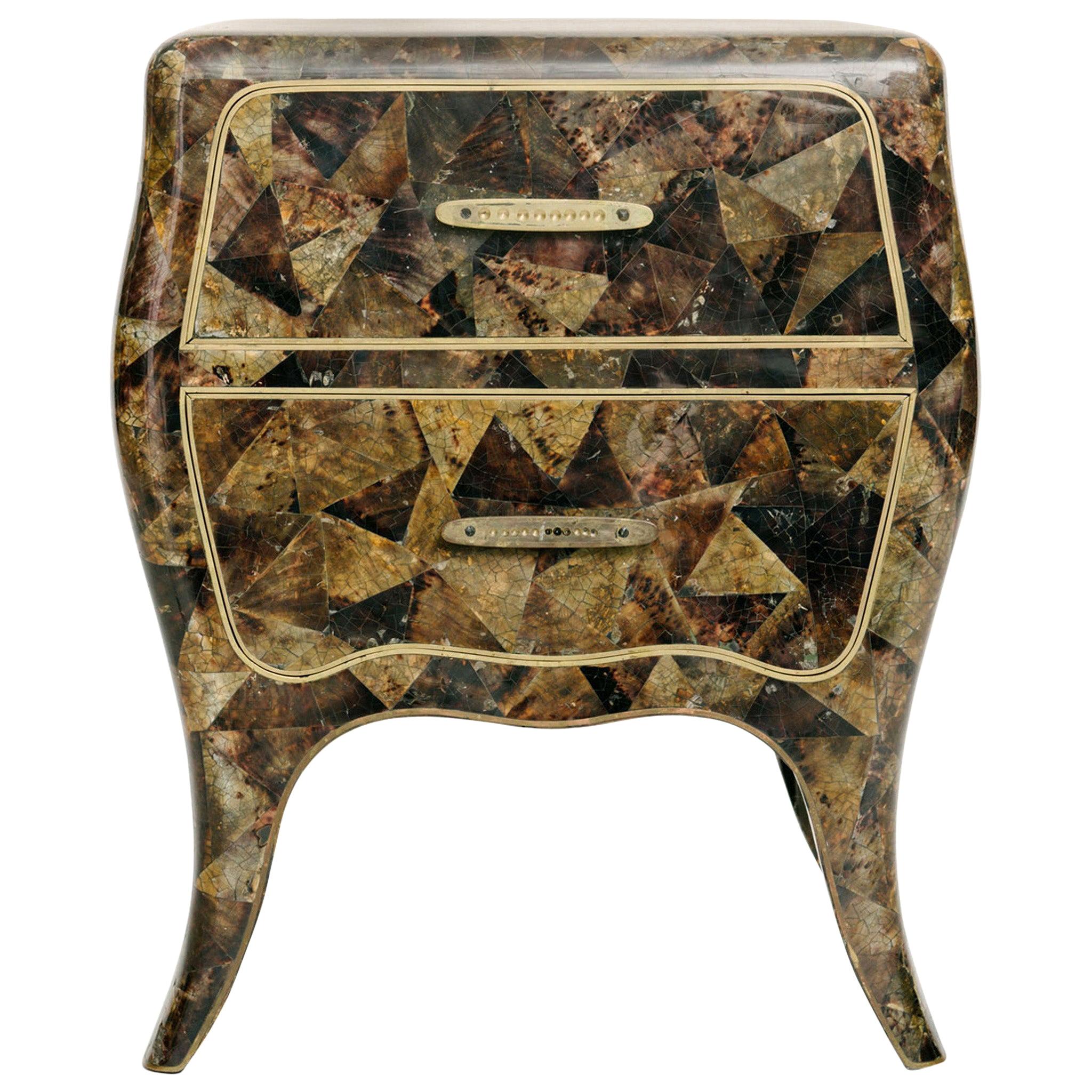Items Similar to Chest of Drawers Chest Commode Architectural Facade Enclosed Renaissance Cedar
Want more images or videos?
Request additional images or videos from the seller
1 of 17
Chest of Drawers Chest Commode Architectural Facade Enclosed Renaissance Cedar
About the Item
A museum quality, English, Late-Renaissance, cedar enclosed chest of drawers with exceptional snakewood, walnut & oak with an architectural or façade front
This is the most sophisticated English model of chest of drawers conceived as a cabinet piece with an architectural front intended to disguise the drawers. This chest exhibits the mastery of English Late-Renaissance, cabinet making combining woods prized for their exoticism, color and beautiful figuring with carving and moulding in different ornamental patterns to simulate materials found within an architectural façade inviting conversation, curiosity and awe. The architectural vocabulary and the use of snakewod which was a highly fashionable exotic timber would be decoded by the cognoscenti as a high status, sophisticated piece which would have been made for a significant interior. Cedar was much prized for its rich color, light figuring and lustrous patina and it is rare to find large pieces in cedar which is why the top has been made from narrow sections. The success lies in the skill of the cabinet maker in balancing proportions, combining layers and different patterns of inlaid, carved and moulded woods of different colors with finely, figured graining to create a striking, statement piece which, when new, would have been very bright and the contrast between the woods would have been dramatic and dazzling. This chest is in exceptional condition, the replaced handles and feet is common as these elements have been subject to so much use over 400 years. It is robust and suitable for everyday use.
In two parts. The cedar top has six vertical sections, crossbanded with a moulded edge with a simulated dentil cornice below.
The upper section is fitted with a shallow, long, top drawer conforming to the frieze of a building with four pairs of double corbels dividing it into three vertical sections. The central section has a large, beautifully figured, snakewood panel surrounded by walnut moulding. The two similarly ornamented sections either side have central snakewood panels surrounded by multi-layered, cedar ‘H’ shaped mouldings with shallow rectangular walnut inlay above, below and snakewood on the sides to create the visual effect of depth.
The second, deep, long drawer in the upper section continues the architectural theme of an upper story of the facade with four cedar capitals and tapering pillars continuing the division into three vertical sections. The central section is headed by a rectangular, cedar section containing the original, chased brass escutcheon with deep cedar moulding aligning with the pillar capitals. Below is a central, walnut arch surrounded by a large, tiered arch, simulating stone, in cedar with snakewood ends and applied snakewood lozenges. The two similarly ornamented sections either side elaborate on the geometric mouldings in the drawer above. They have small central panels of cedar within which the brass handles are mounted, surrounded by a multi-layered, cedar moulding with walnut edge and oak inlaid corners to create depth, surrounded by large, snakewood panels, canted to show the figuring to maximum advantage, within multi-layered, cedar ‘H’ shaped mouldings with shallow snakewood inlay above, below and on the sides.
The lower section continues the architectural theme of the lower storey fitted with two doors, with a frieze of snakewood and walnut capitals above three cedar pillars. The doors with snakewood friezes faced by cedar moulding above massive, ‘H’ shaped moulded panels. Each with a finely, figured, central, cedar section surrounded by multi-layered cedar moulding with inlaid cedar corners and large, canted sections of snakewood within an ‘H’ shaped cedar moulding with snakewood panels above, below and to the sides. They both have skirtings of oak below with cedar inlay and the central pillar is sited on the inside edge of the right door, fitted with the original brass escutcheon. The doors opening to reveal three, fitted, oak drawers with their original, dry patina.
The brass handles are later replacements which is customary, the iron locks, hasp, working locks and two keys are original.
The sides continue the architectural form in a simpler language. The frieze has cedar corbels at either end with a cedar, top, dentil moulding and double ‘D’ lower moulding containing an oak panel with highly figured medullary rays and three geometric cedar panels. Both the upper and the lower sections contain a pair of oak, finely, figured moulded panels echoing those on the front.
Each section of the back has three oak panels.
The stile feet are later replacements which is common. The back feet have been spliced into the side and have characterful iron bands to reinforce the repair.
Provenance: Private collection.
Literature: Victor Chinnery 'Oak Furniture, The British Tradition' figure 3:406 illustrates a similar example.
- Dimensions:Height: 51.58 in (131 cm)Width: 47.05 in (119.5 cm)Depth: 24.81 in (63 cm)
- Style:Renaissance (Of the Period)
- Materials and Techniques:Cedar,Joinery
- Place of Origin:
- Period:Early 17th Century
- Date of Manufacture:circa 1620
- Condition:Wear consistent with age and use.
- Seller Location:BUNGAY, GB
- Reference Number:1stDibs: LU3867319398342
About the Seller
5.0
Vetted Seller
These experienced sellers undergo a comprehensive evaluation by our team of in-house experts.
Established in 1985
1stDibs seller since 2018
84 sales on 1stDibs
Typical response time: 12 hours
- ShippingRetrieving quote...Ships From: BUNGAY, United Kingdom
- Return PolicyA return for this item may be initiated within 7 days of delivery.
More From This SellerView All
- Cassone Venetian 16thc Renaissance Cedar Original Stand Neptune Armorial UnicornLocated in BUNGAY, SUFFOLKA large, museum-quality, late-16th century, cedar, Venetian, cassone on its original stand ; the sea creature ornament probably drawn from De la Cosmographie Universelle, livre III, engraving 1550-1568 • This is the only, known, cassone of this type retaining its original stand. • The collection in Italy that it originally came from was a palazzo that it had reputedly been in for generations of the same family and this most likely why the stand has survived. • The decoration is very unusual, and delightful in the array of sea creatures depicted. The connection of the region with the sea is very strong. • The inner lid is very practical and can be used for display or serving. The interior offers masses of storage space which is particularly suitable for textiles being cedar which repels moths. • The cassone is a beautiful, rich colour and has developed a lustrous patina. • The cassone is Illustrated & discussed in discussed in ‘Woods in British Furniture Making’, (Bowett) c13 Provenance: Private collection, Mayorca. Private collection, Italy Related to: Cassone in V&A collection, no 4886-1858 Width 177 cm., 70 in., Height 87 cm., 34 ½ in. Depth 68 cm. 26 ½ in. With lid open 155 cm., 61 in “Late 16th and 17th century, London inventories confirm that cypress wood chests were relatively common in prosperous households. In 1598 there was a cypress chest in the hall of John Mason, a vintner, valued at 50 shillings. It was the most expensive piece of furniture in the house. Similarly there was a ‘fair cypress chest’ in the great chamber of Adrian Moore, haberdasher, in 1618, and a cypress chest worth £ 9 in the hall of Thomas Willis, a clotherworker in 1630. The chests were sometimes described as ‘great’ or ‘small’ but not otherwise described – presumably they were familiar to the compilers of the inventories. They were placed in halls, chambers and parlours, places where they would have been on prominent view. It is noteworthy that only the chests were imported and not, apparently, the wood. “ (p282, Cypress, Woods in British Furniture making) The decoration is very unusual, and delightful in the array of sea creatures depicted. The connection of the region with the sea is very strong. I have never seen one of these chests on its original stand. The collection in Italy that it came from was a palazzo that it had reputedly been in for generations of the same family and this most likely why the stand has survived. In practical terms, the stand makes the chest a comfortable height to use. The exterior of the chest is a beautiful, mellow colour and has developed a lustrous patina. The top comprises three planks faced with a shallow, cleated, moulded edge nailed on. The front retains its original hasp and lockplate and, as is commonly found, the lock has been removed but, unusually the original ring hinges have survived. The top opens to reveal an inner lid with ring hinges and a brass ring, revealing a large open storage compartment below, the bottom lined with an old fabric. The underside of the lid retains its original penwork and pierced decoration. The central panel depicts sea creatures, sharks, flatfish, monster fish, sea horses, Neptune and mermaids, probably drawn from De la Cosmographie Universelle, livre III, engraving 1550-1568. The panels either side depicting a crown, the sun and unicorns amongst stylised floral sprays. The surrounding naive penwork border features repeats of three naked ladies in the sea, a man wearing an animal mask with two dogs in a forest and a huntsman with two dogs. The floor of the inside of the cassone is upholstered in an 18th century red and yellow striped woven textile the colours of the Catalan flag. The front is decorated with pierced, silhouettes of beasts, trees and figures. The sides are plain with iron carrying handles. On its original stand, with similar decoration, and bearing a cartouche which would have been decorated with the arms of its original owner. Italian, last quarter of the 16th century. Condition Report : Old repair to bottom left moulding of top. Some hairline cracks to top. The hasp, lockplate and ring hinges are original, the lock has been removed. Handles probably 18th century. The inner lid was probably added in the 18th century and supporting mechanism in the 19th century. Exceptional original, lustrous colour and patina. Measures: Width 177 cm. 70 in., height 87 cm. 34 ½ in., depth 68 cm. 26 ½ in. The cassone was the principal piece of furniture in 16th century, Italy. These chests were made as bridal gifts for nobles and aristocrats from cedar specifically for storing their much prized and valued hangings, clothing and linens, as the wood repels moths and the sweet fragrance delicately scents fabrics. Consquently the cassone, as in this example might be decorated with the family coat of arms or with depictions of virtue and edifying episodes from the Bible. A young woman could not be allowed to enter marriage without some instruction. Later, many cassoni were taken apart so that the decorated front panel could be hung as a painting. The stand of this cassone has a cartouche that would have contained a painted coat of arms in the centre which shows that it was conceived for a noble family. Such cypress or cedar chests, incised in bas relief and pyrographically engraved, have long been associated with Venice and typically have a naïve decoration on the exterior. Literature: The 'cypress chests' containing 'arras, counterpoints, costely apparel, tents, and canopies, fine linen, Turkey cushions...Category
Antique 16th Century Italian Renaissance Cabinets
MaterialsCedar
- Cassettone Bureau-Chest Bambocci 16century Italian Renaissance Walnut LombardyLocated in BUNGAY, SUFFOLKAN EXCEPTIONAL MUSEUM QUALITY, ITALIAN, RENAISANCE WALNUT CASSETTONE WITH A FITTED BUREAU IN THE UPPER PART & EXCEPTIONAL BAMBOCCI CARVING, LOMBARDY - This exceptionally rare, museum quality, piece of early furniture was conceived and crafted as an artwork of the finest quality of its time. Throughout time it has been a luxurious, statement piece which has protected it, and fortunately it has survived in virtually, original condition. - This magnificent cassettone exudes the character and quality of the finest, late-Renaissance furniture. Northern Italian Renaissance furniture often had the sides, legs or angles, 'a Bambocci', incorporating carved figures which were considered unique sculptures in their own right. - The putti on this cassettone are beautifully carved and of sculptural quality. Each angel has one arm raised to heaven, a poignant touch. - The lion’s paw feet are a classical feature and make a great statement. - This cassettone was conceived to have visual impact through the quality of the carving, as well as being very practical with the writing compartment fitted in the top part. - It has survived in very original condition with a few small repairs and losses, and the colour and patina are warm and lustrous. - This cassettone is illustrated Illustrated in C. Alberici, Il Mobile Lombardo, Milan, 1969, p. 45, one of the seminal works on Lombardy furniture, and has been in two renowned collections. The hinged top in two sections faced with a solid moulded edge. The front part has a fall front and opens to reveal a writing compartment. The fall front retains its original lock and is concealed with a false drawer which is above three drawers. All with moulded panels, escutcheons and retaining the original iron handles. The front ends have exceptional, bambocci, carved putti raising their arms to heaven above trailing foliage. Standing on magnificent lion's-head carved feet. The sides are panelled. Exceptional original colour and patina. Literature : Illustrated in C. Alberici, Il Mobile Lombardo, Milan, 1969, p. 45. A Gonzalez-Palacois, Il mobile in Liguria, Genova, 1996 illustrates related pieces Measures: Length 147 ½ cm. 58 in, height 104 cm. 41 in, depth 75 cm. 29½ in, Provenance: Coll. Private Azzate The Collection of Sandro and Lidia Orsi, Ca’ Mera, Varese. Regarded as one of the most beautiful homes in Lombardy, Ca’ Mera, the country house of Sandro and Lidia Orsi was filled with beautiful objects from many different epochs. A renowned antiquarian from Milan, over his lifetime Sandro and his wife Lidia revived the Renaissance and Baroque character of the house and instilled their own unique vision into the interiors, which culminated with the creation of a Kunst – or Wunderkammer. “I have never seen such an example of poetical taste”, Sir John Pope...Category
Antique 16th Century Italian Renaissance Commodes and Chests of Drawers
MaterialsWalnut
- Chest of Drawers Campaign Military Mahogany Brass 19th CenturyLocated in BUNGAY, SUFFOLKUnusual small size Striking with the combination of richly coloured mahogany and brass The veneers on this chest are exceptional, creating the effect of pools of ripples moving down ...Category
Antique 1840s English Campaign Commodes and Chests of Drawers
MaterialsMahogany
- Chest of Drawers Table Kneeler Inginocciatoio Walnut Venice Rule Carved BaroqueLocated in BUNGAY, SUFFOLKVenetian, baroque, small, walnut, Inginocchiatoio, table, chest or kneeler with a rule along the right lower end of the right side. - In wonderful original condition with original...Category
Antique 1680s Italian Baroque Commodes and Chests of Drawers
MaterialsWalnut
- Chest of Drawers Oak Cushion Moulding Panelled Bun Feet Drop Handles VernacularLocated in BUNGAY, SUFFOLKLovely, characterful example of a good late-17th century oak chest of drawers with an exceptional lustrous and rich colour and patin...Category
Antique 1660s English Baroque Commodes and Chests of Drawers
MaterialsOak
- Cassettone or Bureau-Chest, Late 16th Century, Italian Renaissance, WalnutLocated in BUNGAY, SUFFOLKExceptional museum quality, Italian, renaissance walnut cassettone with fitted bureau in the upper part & exceptional Bambocci carving, Lombardy. This magnificent cassettone exudes the character and quality of the finest, late-Renaissance furniture. Late 16th century, Northern Italian furniture often had the sides, legs or angles, 'a Bambocci', incorporating carved figures which were unique sculptures in their own right. The putti on this cassettone are beautifully carved and of sculptural quality. Each angel has one arm raised to heaven, a poignant touch. Showing customary signs of wear from time, the lion’s paw feet make a great statement. This cassettone was conceived to have visual impact through the quality of the carving, as well as being very practical with the writing compartment fitted in the top part. It has survived in very original condition with a few small repairs and losses, and the color and patina are warm and lustrous. This cassettone was illustrated in one of the seminal works on Lombardy furniture in the 1969 and has been in two renowned collections. The hinged top in two sections faced with a solid moulded edge. The front part has a fall front and opens to reveal a writing compartment. The fall front retains its original lock and is concealed with a false drawer which is above three drawers. All with moulded panels, escutcheons and retaining the original iron handles. The front ends have exceptional, bambocci, carved putti raising their arms to heaven above trailing foliage. Standing on magnificent lion...Category
Antique 16th Century Italian Baroque Furniture
MaterialsWalnut
You May Also Like
- Booleanos Commode 3 Drawers, Chest of Drawers in Warm Wood Veneer, Joel EscalonaBy Joel EscalonaLocated in Estado de Mexico CP, Estado de MexicoBooleanos Commode 3 Drawers, Chest of Drawers in Warm Wood Veneer, Joel Escalona Booleanos collection reflects the concept of involuntary interactions and unexpected intersections. Geometric cabinet...Category
2010s Mexican Modern Cabinets
MaterialsWood, Plywood
- French Modern Neoclassical Mirror Commode / Chest of Drawers, Serge RocheLocated in New York, NYElegant French Mid-Century patinated mirrored cabinet, commode, chest of drawers, console or credenza in the modern neoclassical style of Serge Roche. The piece has a diamond cut pat...Category
Vintage 1950s Italian Mid-Century Modern Cabinets
MaterialsMirror, Wood
- 19th Century German Biedermeier Cherrywood Chest of Drawers - Antique CommodeLocated in West Palm Beach, FLA 19th century, light-brown antique German Biedermeier chest, commode made of handcrafted Cherrywood, shellac polished and partly veneered in good condition. The cupboard is composed...Category
Antique Early 19th Century German Biedermeier Cabinets
MaterialsMetal
- High Chest of Drawers Spain in Walnut, 1700Located in Lüdinghausen, DEHigh chest of drawers restored Spain around 1700 walnut Features: Mid-height model with three drawers Heavy quality Cassette fillings Drawers pronged Original handles Very n...Category
Antique 17th Century Renaissance Commodes and Chests of Drawers
MaterialsWalnut
- Dutch Chest of Drawers or Commode / Cabinet, in Style of Tejo Remy, Droog DesignBy Tejo RemyLocated in New York, NYA unique Dutch chest or commode or server or sideboard or cabinet composed of 14 distinct, different, drawers with variations in form, size, age, color, design and decoration to crea...Category
20th Century Dutch Mid-Century Modern Commodes and Chests of Drawers
MaterialsWood
- Maitland-Smith Chest of DrawersBy Maitland SmithLocated in Houston, TXVintage Maitland-Smith chest. This wonderful small chest features an all-over chunky geometric horn veneer, two-drawer fronts that are clad in brass along its edges and brass handle ...Category
Late 20th Century American Commodes and Chests of Drawers
MaterialsBrass
Recently Viewed
View AllMore Ways To Browse
With The Head Of
Collection Of Antique Furniture
Makers Of Antique Furniture
Back Of Head
Antique Chest On Chest Chests Of Drawers
Pair Of Heads
Head Of Wood
New Chests
Long Chest
Chest Over Chest
Pair Of Geometrical
Pair Chest Drawers
Pair Chest Of Drawers
Chest Of Drawers Pair
Chest Over
Commode Chest Pair
Pair Of Commode Chests
Pair Chest And Commode





